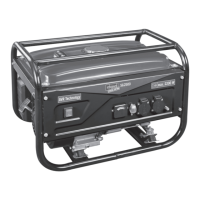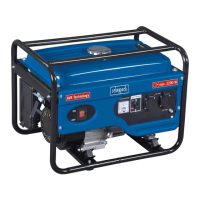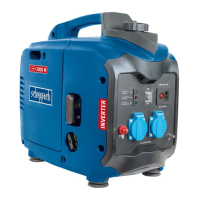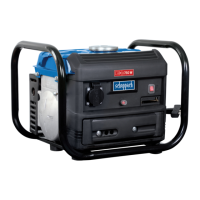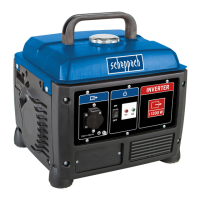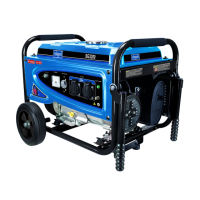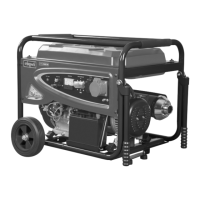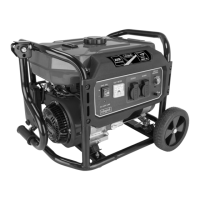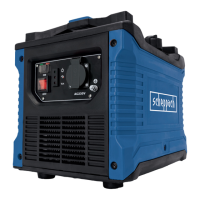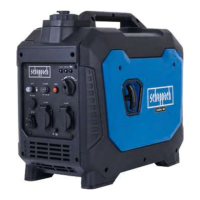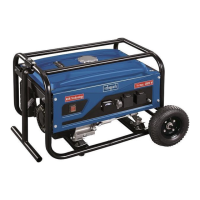www.scheppach.com
30
|
GB
9.2 Shutting the engine o
Allow the power generator to run for a short time (ap-
prox. 30 seconds) without load before switching it o so
that it can “cool down”.
1. Set the on/o switch (13) to the “OFF” position.
2. Disconnect the power consumers from the device.
3. Set the ventilation on the tank cover (2) to “OFF”.
9.3 Operating display (6) (Fig. 3)
The operating display is active when the engine is run-
ning.
9.4 Overload indicator (7) (Fig. 3)
The overload protection becomes active if the power
consumption is too high and switches o the 230 V
~
socket (9).
1. Switch the device o as described in section 10.2.
2. Disconnect the power consumers from the device.
9.5 Oil warning indicator (8) (Fig. 3)
The indicator activates when the oil level is too low and
deactivates as soon as the oil level is sucient.
9.6 Automatic oil cut-o
The automatic oil cut-o system responds when there
is too little engine oil. The oil warning indicator (8) starts
ashing when there is too little oil in the engine. The indi-
cator lamp starts to light up when the oil quantity has not
reached the safety quantity. The engine switches itself
o after a short time. It is not possible to start the engine
until the engine oil has been lled (see chapter 9.1).
9.7 Energy saving switch (10) (Fig. 3)
To reduce the fuel consumption when idle, move the
energy saving switch (10) to the “ON” position.
The energy saving switch (10) must be switched o
when electrical devices that require a high starting cur-
rent are connected, for example a compressor. Even
when the power generator is started, the energy saving
switch must be initially set to “OFF”.
9.8 USB connection (11) (Fig. 3)
This power generator is equipped with two USB con-
nections. These can be used to charge smartphones
for example.
10. Cleaning and maintenance
Before carrying out any cleaning or maintenance work,
switch o the engine and remove the spark plug con-
nector (21) from the spark plug (20).
m ATTENTION!
Refuel in a well-ventilated area with the engine
stopped.
If the engine was in operation immediately before,
allow it to cool rst. Never refuel the engine in a
building where the petrol vapour may come into
contact with ames or sparks.
Petrol is highly inammable and explosive. When
handling fuels, you may suer burns or other se-
vere injuries.
9. Operation
9.1 Starting the engine (Fig. 5 + 6)
m Attention! Danger of poisoning!
Only use the device outdoors and never in closed or
poorly ventilated rooms.
1. Set the ventilation on the tank cover (2) to “ON”.
2. Set the on/o switch (13) to the “RUN” position.
Note: The energy saving switch (10) must be set to
“OFF”.
When the engine is cold
1. Attention! Never allow the recoil starter (5) to spin
back. This can result in damage.
2. Set the on/o switch (13) to the “CHOKE” position.
3. Now pull the recoil starter (5) and the engine should
start. If the engine does not start, repeat the process.
4. Move the on/o switch (13) from the “CHOKE” po-
sition to the “RUN” position after starting the en-
gine (after approx. 15-30 seconds). (Fig. 6)
5. If the engine does not start even after several at-
tempts, read the “Troubleshooting” chapter.
Note: With high outside temperatures, it may be nec-
essary to start the power generator without the choke
even when the engine is cold!
When the engine is warm
1. Set the on/o switch (13) to the “RUN” position.
2. Now pull the recoil starter (5) quickly. The device
should start after a maximum of 2 pulls. If the
device has still not started, repeat the procedure
described under “Starting the engine when cold”.
Note:
If the engine is being started for the rst time, several
tries are required to start until the fuel has been deliv-
ered from the tank to the engine.
1. Move the on/o switch (13) from the “CHOKE” po-
sition to the “RUN” position after starting the en-
gine (after approx. 15-30 seconds). (Fig. 6)
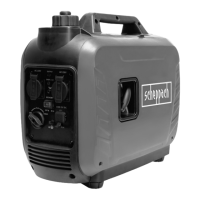
